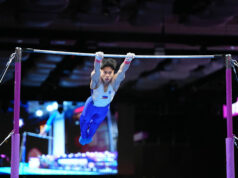The FIDE World Cup started with 128 players three Saturdays ago and now, after round 5, there are 4 players left standing.
Results of Round 5 (Quarterfinals):
Top Half
Peter Svidler RUS 2756 vs Maxime Vachier Lagrave FRA 2804, 1.5-2.5
Vassily Ivanchuk UKR 2727 vs Levon Aronian ARM 2802, 0.5-1.5
Bottom Half
Wesley So USA 2792 vs Vladimir Fedoseev RUS 2731, 1.5-0.5
Richard Rapport HUN 2675 vs Ding Liren CHN 2771, 0.5-1.5
Pairings for Round 6 (Semifinals):
Maxime Vachier-Lagrave vs Levon Aronian ARM 2802
Wesley So USA 2792 vs Ding Liren CHN 2771
The two winners from round 6 will be seeded automatically into the Candidates’ Tournament tentatively set for March 2018. They will also face off for the World Cup title in round 7.
A lot of money is at stake here:
Round 6 losers: $50,000 each
Round 7 loser : $80,000
Round 7 winner: $120,000
Wesley So played a great game in round 5 to defeat the rising Russian Star Vladimir Fedoseev. Let us look at this in more depth.
Anatoly Karpov is the 12th World Chess Champion. He first won the championship when Bobby Fischer refused to defend his title in 1975. Karpov was to reign until 1985 when he was defeated by Garry Kasparov. He became World Champion again in 1993-1999 when Kasparov broke away from FIDE.
Karpov has won more than 160 international tournaments and is considered by many to be among the top 3 chessplayers of all time. He has no weaknesses — extremely accurate in tactics, unparalleled endgame technique, equally adept at attack or defense. It doesn’t matter whether his position is better, equal or inferior — he has this boa constrictor style which takes out one by one his opponent’s options and then accumulates his own tiny advantages to get the best result possible from the position.
It is a great compliment to be compared with Anatoly Karpov, but that is what the chess world is saying now. NM Sam Copeland from chessvibes.com sums up the Wesley So vs Fedoseev game as follows: “Wesley So has been said to have a Karpovian style. Today it was on full display. In a symmetrical Petroff that many would have drawn quickly, he collected small advantages that soon compounded. The same-colored bishop endgame he then won was masterful; in particular, the Bd6-a3-c1-d2-e1 maneuver was highly instructive, a perfect addition to a Shereshevsky endgame book.”
Wow. Great praise indeed, but play over the game and I think you will agree with the assessment.
* * *
So, Wesley (2792) — Fedoseev, Vladimir (2731) [C42]
FIDE World Cup 2017 Tbilisi (5.2), 16.09.2017
Wesley gave highlights of the game in his interview with Chessbase India — I have integrated his comments in the notes below.
1.e4 e5 2.Nf3 Nf6
A surprise on the second move! Wesley did not expect this as Fedoseev has never before played the Petroff in his career. With Black after 1.e4 his main weapon is the Sicilian 1…c5. In those instances he chooses to reply 1.e4 e5 after 2.Nf3 he always goes 2…Nc6.
3.Nxe5 d6 4.Nf3 Nxe4 5.d4 d5 6.Bd3 Be7 7.0–0 Nc6 8.Nbd2
Wesley So: I noticed that Anish Giri plays 8.Nbd2 here. As one of the best prepared players in the world anything Anish plays must be good.
8…Bf5 9.Re1 Nxd2 10.Qxd2 Bxd3 11.Qxd3 0–0 12.c3 Qd7 13.Bf4 a6 14.Re2 Rae8 15.Rae1 Bd8 16.Nd2 Rxe2 17.Qxe2 a5
This is a new move, previously played was 17…Be7. 17…a5 though is the first choice for computer engines, perhaps with the intention of eliminating the weakness on c5. After White’s Nb3 Black can now reply …b7–b6 followed by …a5–a4 to kick away the knight.
18.Nb3!
GM Wesley nevertheless brings the knight to b3. This is a remarkably deep move and the reasoning behind it goes like this: To break White’s hold on the e-file Black will have to play …f6 followed by Rf8–f7–e7. A weakness on e6 is created and the knight will be going to b3–c1–d3–f4–e6 to exploit it. Wow. He saw all that?
18…b6 19.Nc1 f6 20.a4 Ne7
It is not yet time for …Rf7 because White has Qb5, so Black first relocates his knight to g6. Obviously this has all been prepared by Fedoseev — at this point he had 1 hour and 37 minutes left, which, because of the 30-second increment after every move, is 7 minutes more than the time he had at the beginning of the game.
21.Nd3 g5?!
Obviously still part of Fedoseev’s master plan, but GM Wesley thinks that this is a bad move as it creates weaknesses in Black’s pawn structure.
22.Bc1
Wesley So: I think Fedoseev expected Bg3.
22…Ng6 23.b3 Be7?
Now this is clearly a mistake. It was already time to simplify with 23…Rf7 followed by …Re7. With the rooks off the board White’s initiative is kept to the minimum.
24.h4! gxh4
[24…Nxh4?? 25.Qxe7]
25.Nf4 Rf7 26.Qe6 Qxe6 27.Rxe6
White has the better pawn structure. Although he is a pawn down now GM Wesley is not worried about that since he expects that both of the Black pawns on the h-file will fall sooner or later.
27…Nxf4 28.Bxf4 Bd8 29.b4! Kg7
Of course not 29…axb4 30.cxb4 which gives White an outside passed pawn.
30.bxa5 bxa5 31.Ra6 c6 32.Rxc6 Kg6 33.Rc5 Rd7 34.f3 Kf5 35.Bd2 Ke6 36.Rc6+ Kf5 37.Be1 Kg5 38.Rc5 f5 39.Kh2 Kh5 40.Bf2 Rd6 41.Be3 Bb6 42.Rb5 Bd8 43.Bf4 Rd7 44.Be5 Kg5 45.Rc5 f4?
Wesley was happy to see this pawn go to f4. Now Black’s scattered pawns on a5, f4 and h4 are all on dark squares — the same color as his bishop, and he knew he would pick them off sooner or later.
46.Rc6 Kf5 <D>
POSITION AFTER 46…KF5
The problem now is that Wesley has 8 minutes left (plus the 30-second-per-move increment) for the rest of the game. Fedoseev on the other hand still had 35 minutes. White’s advantage is obvious but can he find a way to zugzwang a win? It was around 11:15 p.m. on a Friday night in Manila and I sat transfixed in front of the computer screen watching the game unfold with heart pounding. I was unable to eat or sleep or do anything at all, only pray.
47.Ra6 Kg5 48.Kh3 Kf5 49.Rc6 Kg5 50.Re6 Be7 51.Rc6 Bd8 52.Bd6 Kf5 53.Kh2 Rg7 54.Be5 Rd7 55.Rd6!
We were watching this game on chess24.com, which featured live computer analysis of the games. Wesley was given a 2.5-point lead (roughly translated to a lead of two and a half pawns) before this move, but after 55.Rd6 his lead fell to 0.5 (although after a while it goes up to 1.92 again). Obviously the computer engines did not like exchanging rooks. Wesley revealed though that he had given this a lot of thought and figured it would be easier to win the game without the rooks. To prove this point White spent 2 minutes on this move, using up most of his remaining time, but then blitzed out his remaining moves, even 65.Be1 took just a few seconds.
55…Rxd6 56.Bxd6 Kg5 57.Kg1 Kf5 58.Kf2 Kg5 59.Kf1 Kf5 60.Ba3 Ke6 61.Ke2 Kf5 62.Bc1 Kg5 63.Kf1 Bc7 64.Bd2 Bd8 65.Be1!
Very nice. Wesley will be moving his King to e2–d3 and he wants to make sure Black cannot counter with …h4–h3, gxh3, …Kh4 and penetrate to the kingside.
65…Kf5 66.Ke2 Ke6 67.Kd3 Kd7 68.c4 Kc6 69.Bc3!
Zugzwang is about to be created.
69…Bb6 70.Bb2 Bd8 71.Bc1 Bc7 72.Bd2 h5 73.Bc3 Bb6 74.Bb2 Bc7 75.Ba3 Bd8 76.Bf8 Bg5 77.Bg7 Kd6 78.Be5+ Kc6
If 78…Ke6 79.Bc7 Black’s a5–pawn will fall. By the way, Wesley made a comment during the interview that there is a bit of luck here — if the two pawns on the a-file had been on a6 and a5 rather than on a5 and a4 as in the game then the ending is a draw.
79.Kc3!
Finally zugzwang has been achieved. Black is lost — if he moves his bishop then either the f4 or h4 pawn will fall. Moving the king though will lose the d5–pawn, and 79…dxc4 80.Kxc4 will allow White to start pushing his d-pawn.
79…Bh6 80.Bf6 Bf8 81.Kd3 h3 82.gxh3 Bd6 83.Be5! 1–0
Forcing the bishop exchange and then the pawn endgame is easy. Interestingly enough, at the end of the game Wesley So because of the 30-second increment had built his time back up to 9 minutes, while Fedoseev had only 3 minutes left.
To all BWorld readers — we have just seen a strategic masterpiece executed with almost perfect technique. No kidding — truly worthy of the adjective “Karpovian.”
Very soon we will kknow who the World Cup winners are. Keep your fingers crossed!
Bobby Ang is a founding member of the National Chess Federation of the Philippines (NCFP) and its first Executive Director. A Certified Public Accountant (CPA), he taught accounting in the University of Santo Tomas (UST) for 25 years and is currently Chief Audit Executive of the Equicom Group of Companies.



